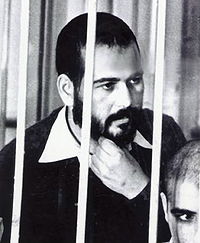Khalid Islambouli
| Khalid el Islambouli | |
|---|---|

Khalid Islambouli, 1982
|
|
| Born | 15 January 1955 |
| Died | 15 April 1982 (aged 27) |
| Allegiance |
|
| Service/branch | Egyptian Army |
| Years of service | 1976–1981 |
| Rank |
|
| Unit | 17th Artillery Regiment |
Khalid Ahmed Showky Al-Islambouli (Arabic: خالد أحمد شوقى الإسلامبولى, Egyptian Arabic pronunciation: [ˈxæːled ˈæħmæd ˈʃæwʔi (e)lʔeslæmˈbuːli]) (15 January 1955 – 15 April 1982) was an Egyptian army officer who planned and participated in the assassination of Egypt's third president, Anwar Sadat, during the annual 6th October victory parade on 6 October 1981. Islambouli stated that his primary motivation for the assassination was Sadat's signing of the Camp David Accords with the State of Israel. He was tried by a military tribunal, found guilty, and sentenced to death. Following his execution, Islambouli was declared a martyr by many radicals in the Islamic world, and became an inspirational symbol for radical Islamic movements as one of the first 'modern martyrs' for Islam.
Islambouli's father was an Egyptian legal advisor and his mother was of Turkish descent. After graduating from the Egyptian Military Academy, he was commissioned as an officer in the Artillery Forces of the Egyptian Army with the rank of Second Lieutenant. Sometime after this appointment, Islambouli joined the proscribed Egyptian Islamic Jihad movement. Between 1976 and 1980, he served mostly as a staff officer or as fire direction officer for various Artillery batteries, battalions and regiments. In March 1980, he got his first field command, an Artillery platoon gun line in the 116th Field Artillery Brigade based in Cairo. His command included three 'active' field howitzers, a reserve field gun, five to six transport trucks, seven jeeps, signaling equipment, light infantry weapons such as assault rifles, medium machine guns, anti-Tank rockets, light mortars, and sniper rifles for organic defence, and around 45 soldiers/conscripts, with a Second Lieutenant and a Sergeant acting as second-in-command and third-in-command respectively. His role was to take firing missions and orders from the Battery HQ. Apparently, he was scheduled and approved for promotion to Captain by December 1981 and for posting as Staff Officer-III in a Brigade HQ.
...
Wikipedia
